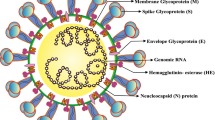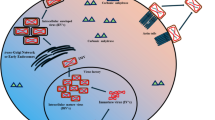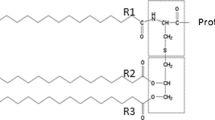Summary
The effect of immunisation with an HSV-1 antigen preparation (containing at least 6 viral glycoproteins) on primary infection with HSV and the establishment of latency, was assessed in two mouse models (involving either skin or corneal challenge with virus). The vaccine preparation, given either with Freunds complete adjuvant or aluminium hydroxide gel or in the form of immunostimulating complexes (ISCOMS), induced high ELISA antibody responses (highest with HSV as the ISCOM preparation) and low levels of neutralising antibody. In both models, immunisation with the HSV ISCOM preparation significantly reduced the incidence of zosteriform spread of virus and the severity of disease and, in some cases, the incidence of latent infection in sensory ganglia. In the eye model it was possible to show that immunisation with the HSV ISCOMS restricted the establishment of latency almost entirely to the ophthalmic part of the trigeminal ganglion. Protection from establishment of latency correlated with prechallenge antibody levels.
Similar content being viewed by others
References
Al-Ghamdi A, Jennings R, Bentley H, Potter CW (1989) Latent HSV-1 infection in mice immunised with a zwitterionic detergent-extracted HSV-1 antigen preparation. Arch Virol 108: 19–31
Allen JC, Humphries C (1975) The use of zwitterionic surfactants in the agarose chromatography of biological membranes. FEBS Lett 57: 158–162
Balachandran N, Bacchetti S, Rawls WE (1987) Protection against lethal challenge of Balb/c mice by passive transfer of monoclonal antibodies to five glycoproteins of herpes simplex virus type-2. Infect Immun 37: 1132–1137
Bernstein DI, Stanberry LR (1986) Zosteriform spread of herpes simplex virus type 2 genital infection in the guinea-pig. J Gen Virol 67: 1851–1857
Blyth WA, Harbour DA, Hill TJ (1984) Pathogenesis of zosteriform spread of herpes simplex virus in the mouse. J Gen Virol 65: 1477–1486
Bonneau RH, Jennings SR, (1989) Modulation of acute and latent herpes simplex virus infection in C 57 BL/6 mice by adoptive transfer of immune lymphocytes with cytotoxic activity. J Virol 63: 1480–1484
Corey L, Spear PG (1986) Infections with herpes simplex viruses. N Engl J Med 314: 686–691
Cremer KJ, Mackett M, Wohlenberg C, Notkins AL, Moss B (1985) Vaccinia virus recombinant expressing herpes simplex virus type 1 glycoprotein D prevents latent herpes in mice. Science 228: 737–740
Dix RD, Pereira L, Baringer JR (1981) Use of monoclonal antibody directed against herpes simplex virus glyco-proteins to protect mice against acute virus-induced neurological disease Infect Immun 34: 192–199
Eisenberg RJ, Cerini CP, Heilman CJ, Joseph AD, Dietzschold B, Golub E, Long D, Ponce de Leon M, Cohen GH (1985) Synthetic glycoprotein D-related peptides protect mice against herpes simplex virus challenge. J Virol 56: 1014–1017
Erturk M, Jennings R, Hockley D, Potter CW (1989) Antibody responses and protection in mice immunised with herpes simplex virus type-1 antigen immune-stimulating complex preparations. J Gen Virol 70: 2149–2155
Erturk M, Phillpotts RJ, Jennings R, Hockley D, Potter CW (1991) Biochemical characterisation of herpes simplex virus type-1 immunostimulating complexes (ISCOMS): a multi-glycoprotein structure. Vaccine 9: 668–674
Erturk M, Phillpotts RJ, Welch MJ, Jennings R (1991) Efficacy of HSV-1 ISCOM vaccine in the guinea-pig model of HSV-2 infection. Vaccine 9: 728–734
Erturk M, Welch MJ, Phillpotts RJ, Jennings R (1989) Protection and serum antibody responses in guinea-pigs and mice immunised with HSV-1 antigen preparations obtained using different detergents. Vaccine 7: 431–436
Harbour DA, Hill TJ, Blyth WA (1981) Acute and recurrent herpes simplex in several strains of mice. J Gen Virol 55: 31–40
Harbour DA, Hill TJ, Blyth WA (1983) Recurrent herpes simplex in the mouse: inflammation in the skin and activation of virus in the ganglia following peripheral inoculation. J Gen Virol 64: 1491–1498
Hill TJ (1985) Herpes simplex virus latency. In: Roizman B (ed) The herpesviruses, vol 3. Plenum, New York, pp 175–240
Hill TJ (1987) Ocular pathogenicity of herpes simplex virus. Curr Eye Res 6: 1–7
Hill TJ, Altmann DM, Blyth WA, Harbour DA, Whitby A (1984) Herpes simplex virus latency. Clin Dermatol 2: 46–55
Hill TJ, Field HJ, Blyth WA (1975) Acute and recurrent infection with herpes simplex virus in the mouse: a model for studying latency and recurrent disease. J Gen Virol 28: 341–353
Igietseme JV, Calzada PJ, Gonzalez AR, Streilein JW, Atherton SS (1989) Protection of mice from herpes simplex virus-induced retinitis by in vitro-activated immune cells. J Virol 63: 4808–4813
Jennings R, Erturk M (1990) Comparative studies of HSV-1 antigens solubilised from infected cells by using non-ionic or zwitterionic detergents. J Med Virol 31: 98–108
Jennings R, Quasim T, Sharrard RM, Hockley D, Potter CW (1988) Zwitterionic detergent solubilisation of HSV-1 surface antigens. Arch Virol 98: 137–153
Kohl S, Loo LS (1982) Protection of neonatal mice against herpes simplex virus infection: probable in vivo antibody-dependent cellular cytotoxicity. J Immunol 129: 370–376
Kapoor AK, Nash A, Wildy P (1982) Pathogenesis of herpes simplex virus in B cell-suppressed mice: the relative roles of cell-mediated and humoral immunity. J Gen Virol 61: 127–131
Kumel G, Kaerner HC, Levine M, Schroder CH, Glorioso JC (1985) Passive immune protection by herpes simplex virus-specific monoclonal antibodies and monoclonal antibody resistant mutants altered in pathogenicity. J Virol 56: 930–937
Long D, Madara TJ, Ponce de Leon M, Cohen GH, Montgomery PC, Eisenberg RJ (1984) Glycoprotein D protects mice against lethal challenge with herpes simplex virus types 1 and 2. Infect Immun 37: 761–764
Lowry O, Rosebrough NJ, Farr AL, Randall TJ (1951) Protein measurements with the Folin phenol reagent. J Biol Chem 193: 265–275
Martin RG, Dawson CR, Jones P, Togni B, Lyons C, Oh JO (1977) Herpes virus in sensory and autonomic ganglia after eye infections. Arch Ophthalmol 95: 2053–2056
Meignier B, Jourdier TM, Norrild B, Pereira L, Roizman B (1987) Immunization of experimental animals with reconstituted glycoprotein mixtures of herpes simplex virus 1 and 2: protection against challenge with virulent virus. J Infect Dis 155: 921–930
McDermott MR, Brais LJ, Evelegh MJ (1990) Mucosal and systemic antiviral antibodies in mice inoculated intra-vaginally with herpes simplex virus type 2. J Gen Virol 71: 1497–1504
McKendall RR (1985) IgG-mediated clearance in experimental infection with herpes simplex virus type 1: role for neutralisation and Fc-dependent functions but not C′ cytolysis and C 5 chemotaxis. J Infect Dis 151: 464–470
Mertz GJ, Ashley R, Burke RL, Benedetti J, Critchlow C, Jones CC, Corey L (1990) Double-blind, placebo-controlled trial of a Herpes simplex virus type 2 glycoprotein vaccine in persons at high risk for genital herpes infection. J Infect Dis 161: 653–660
Mester JC, Glorioso JC, Rouse BT (1991) Protection against zosteriform spread of herpes simplex virus by monoclonal antibodies. J Infect Dis 163: 263–269
Morein B, Sundquist B, Hoglund S, Dalsgaard K, Osterhaus A (1984) Iscom, a novel structure for antigenic presentation of membrane proteins from enveloped viruses. Nature 308: 457–460
Music SI, Fine EM, Togo Y (1971) Zoster-like disease in the newborn due to herpes simplex virus. N Engl J Med 284: 20–24
Paoletti E, Lipinskas BR, Samsonoff C, Mercer S, Panacali D (1984) Construction of live vaccines using genetically engineered poxviruses: biological activity of vaccinia virus recombinants expressing the hepatitis B surface antigen and the herpes simplex virus glycoprotein D. Proc Natl Acad Sci USA 81: 193–197
Rector JT, Lausch RN, Oakes KE (1982) Use of monoclonal antibodies for analysis of antibody-dependent immunity to ocular herpes simplex virus type 1 infection. Infect Immun 38: 168–174
Rodrigues MM, Rowden G, Hackett J, Bakos I (1981) Langerhans cells in normal conjunctiva and peripheral cornea of selected species. Invest Ophthalmol Vis Sci 21: 759–765
Roizman B, Meignier B, Norrild B, Wagner JL (1984) Bioengineering of herpes simplex virus variants of potential use as live vaccines. In: Lerner RA, Chanock RM (eds) Modern approaches to vaccines. Cold Spring Harbour Laboratory, New York, pp 275–282
Shimeld C, Hill TJ, Blyth WA, Easty DL (1990) Passive immunisation protects the mouse eye from damage after herpes simplex virus infection by limiting spread of virus in the nervous system. J Gen Virol 71: 681–687
Simmons A, Nash AA (1984) Zosteriform spread of herpes simplex virus as a model of recrudescence and its use to investigate the role of immune cells in prevention of recurrent disease. J Virol 52: 816–821
Simmons A, Nash AA (1985) Role of antibody in primary and recurrent herpes simplex virus infection. J Virol 53: 944–948
Simmons A, Nash AA (1987) Effect of B cell suppression on primary infection and reinfection of mice with herpes simplex virus. J Infect Dis 155: 649–654
Steiner I, Spivack JG, Deshmane SL, Ace CI, Preston CM, Fraser NW (1990) A herpes simplex virus type 1 mutant containing a non-transinducing Vmw 65 protein establishes latent infection in vivo in the absence of viral replication and reactivates efficiently from explanted trigeminal ganglia. J Virol 64: 1630–1638
Tullo AB, Shimeld C, Blyth WA, Hill TJ, Easty DL (1982) Spread of virus and distribution of latent infection following ocular herpes simplex in the non-immune and immune mouse. J Gen Virol 63: 95–101
Tullo AB, Shimeld C, Blyth WA, Hill TJ, Easty DL (1983) Ocular infection with herpes simplex virus in non-immune and immune mice. Arch Ophthamol 102: 961–964
Author information
Authors and Affiliations
Rights and permissions
About this article
Cite this article
Erturk, M., Hill, T.J., Shimeld, C. et al. Acute and latent infection of mice immunised with HSV-1 ISCOM vaccine. Archives of Virology 125, 87–101 (1992). https://doi.org/10.1007/BF01309630
Received:
Accepted:
Issue Date:
DOI: https://doi.org/10.1007/BF01309630




